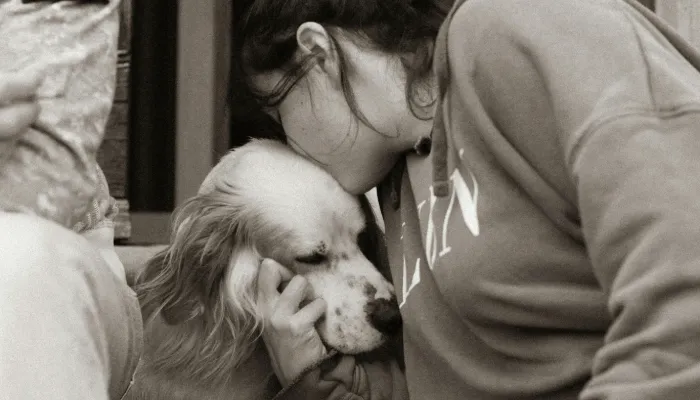Usually, when we think of goodbyes, we think of people hugging, shaking hands or simply speaking farewell phrases. But have you considered, how do dogs say “goodbye”? As you develop a relationship with your beloved pet, it is your dog’s emotions that tell you that pets communicate in different ways. Relatively speaking, every dog has a unique way of saying goodbye, be it through actions, vocalizations, or even body language.
Thanks to the dog translator, we are able to recognize these subtle gestures and movements better. In this post, we will uncover the methods pets use to express their love and feelings during farewells.

The Body Language of Dogs
Dogs are known to often use their body to communicate with others. Unlike humans, dogs cannot talk, so they communicate through physical actions and gestures. Therefore, how do dogs say “goodbye” physically? Some examples are given below:
1. Tail Wagging
- A dog’s tail is a clear indicator of their mood.
- Fast wagging typically signifies excitement or happiness.
- Slow wagging, especially when the tail is down depicts sadness and reluctance.
2. Head Low, Ears Back
- When dogs are sad, they tend to lower their head and tuck their ears.
- This could indicate abandonment or the sadness caused by a departure.
3. Licking Or Pawing
- If your dog is licking your palm or lightly pawing you, it could signal ‘I want your attention’ or an attempt to ask ‘please do not leave.”
4. Barking Or Whining
- While departing, some dogs display their sadness through gentle whining or even barking.
- Simply put, it can be their way of telling you that they are not ready to say goodbye.
5. A Silent Response
- It could also mean that when it’s time to say goodbye, some dogs would rather be left alone.
There are many ways of observing canine behavior and how dogs say goodbye is one of them.
Vocalizations: More Than Just Barking
Dogs possess the ability to communicate in a much wider range aside from using their bodies and facial expressions. So how do dogs say “goodbye”? The answer can be found in their vocalizations, which include barking, whining, or even growling when they feel something. Here’s how dogs bid farewell using their voices:
1. Whining Softly
- For example, whining softly signals a dog’s anxious or sad feelings.
- When a dog whimpers quietly, it is usually in the form of an emotional plea that indicates a wish for their owner to stay with them.
2. Excited Barking
- When you are about to leave a place, a dog may bark in a more energetic manner. They are usually not upset, rather, it’s a sign of happiness.
- Energetic barking might also be a sign of wanting to interact with you.
3. Quiet Growls
- While this is rare, some possessive dogs may emit quiet low growls as a reaction to a person trying to approach or disturb their owner.
4. Howling
- Dogs often howl as a behavioral outlet.
- A dog may also use howling as a signal for the owner to return or as a sign of missing him/her.
With respect to barking, howling, and whining, vocal sounds can therefore serve as most means of saying goodbye.
Behavior That Follows a Goodbye
In some cases, a dog’s behavior after you say goodbye can be concerning. How do dogs say “goodbye” without showing any actions in front of you?
1. Restlessness
- After you leave, your dog might be wandering around the house or sitting by the door. This could be indicative of separation anxiety, or a reaction to your absence.
2. Favorite Sleeping Spot
- Some dogs might retreat to their favorite resting place, curling up to wait for you to return. The spot creates a resting comfort until you return.
3. Refusal to Eat and Drink
- Escape or avoidance coping mechanisms can often interfere with a dog’s appetite. If a dog refuses food and water after a goodbye, it implies they are feeling emotionally disturbed.
4 Searching for You
- Additionally, other dogs will sniff around the house looking for you. This can often be a sign of poor separation coping and instinctively looking ‘for the next move’ after saying goodbye.
A dog’s behavior after a goodbye gives a glimpse into how much they miss you. These actions show how much the dog emotionally adjusts and how the dog copes with the absence.
The Emotional Bond: How Dogs Feel When You Leave
“How Do Dogs Say “Goodbye“?” gives a glimpse into the emotional bond and connection they build with their owners. Dogs are social animals which creates a strong attachment between the breed and the human. This bond is the reason for their feelings of anxiety, sadness, or joy due to the absence of their owners.
1. Separation Anxiety
- One condition that many dogs face is separation anxiety – this is where they tend to become anxious or distressed due to prolonged periods of silence and loneliness. This condition is more common in puppies or dogs that have gone through trauma in the past.
2. Attachment to Routine
- Dogs are creatures of habit and are very attached to their daily routines. Any deviation from a set norm, such as your departure in this instance, can leave them feeling anxious.
3. Joyful Reunion
- The other side of the emotional bond is the delight and enthusiasm dogs show when you come back. Their instincts let them forgive easily, and their happiness at your return is one of the many signs of how much they love you.
Goodbyes never seem easy, do they? It is even more difficult to say goodbye to your furry friend as it is hard to fathom your pet feeling hurt over the emotional bond you share. Recognizing this connection can help mitigate the feelings of anxiety or stress that you or your pet may go through while parting.
Conclusion
So, what are the ways dogs say “goodbye”? Though they do not possess any words to bid farewell, they express it with their gestures, sounds, and in different activities they take part in. These cues are often overlooked, but they are pivotal in grasping the emotional expression of your pet.
With developments like dog translators, comprehending human and dog language has become simpler. Although this moment is extremely sensitive for both of you, noticing these signals will help you understand and prepare for the actions that will follow.
